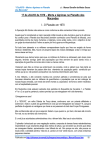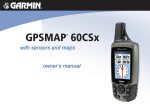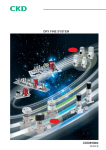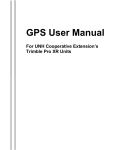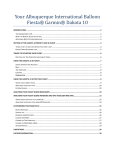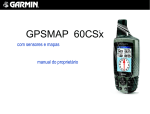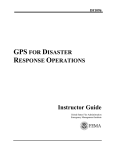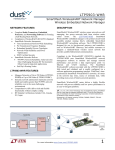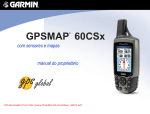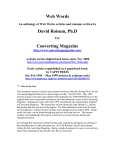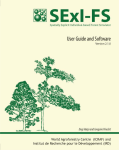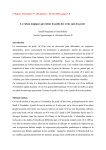Download Field Guide for
Transcript
Woods Hole Research Center Field Guide for Version 1.0 Purpose This field guide provides an introduction to the basic tools and techniques used in obtaining ground-based estimates of aboveground forest biomass and carbon. It was written for a general audience, emphasizing fundamental skills and real-world examples. A modular approach was taken such that additional topics (chapters) could be added as desired. Specifically, Version 1.0 of this field guide: • Explains the basics of GPS and GPS navigation • Describes how to establish sample plots used in obtaining forest measurements • Explains how to take tree diameter measurements used in forest biomass estimation • Demonstrates how to compute estimates of forest carbon storage from sample plot data • Serves as a reference for both field and office use • Incorporates graphical illustrations for multi-lingual users • Is not a substitute for formal instruction and hands-on training Produced by: Woods Hole Research Center/Dr. Wayne Walker; Version 1.0, June 2011 Suggested citation: Walker, W., A. Baccini, M. Nepstad, N. Horning, D. Knight, E. Braun, and A. Bausch. 2011. Field Guide for Forest Biomass and Carbon Estimation. Version 1.0. Woods Hole Research Center, Falmouth, Massachusetts, USA. Funding provided by: Gordon and Betty Moore Foundation Google.org The David and Lucile Packard Foundation Norwegian Agency for Development Cooperation/Forum on Readiness for REDD Layout adapted from: 2009 Commonwealth of the Northern Mariana Islands (CNMI) Erosion and Sediment Control Field Guide, CNMI Department of Environmental Quality. CHAPTER 1 Introduction CHAPTER 2 GPS Navigation CHAPTER 3 Sample Plot Layout CHAPTER 4 Tree Diameter Measurement CHAPTER 5 Biomass and Carbon Estimation CHAPTER 6 Additional Resources License information: This field guide is licensed under the Creative Commons Attribution-NonCommercial 3.0 Unported License. To view a copy of this license, visit http://creativecommons.org/licenses/by-nc/3.0/ or send a letter to Creative Commons, 444 Castro Street, Suite 900, Mountain View, California, 94041, USA. You are free to adapt, copy, distribute, and transmit the guide under the following conditions: • You must attribute the work in the manner specified by the author or licensor (but not in any way that suggests that they endorse you or your use of the work). • You may not use this work for commercial purposes. If you make reference to this field guide we ask that you use the citation suggested on the inside front cover. Chapter 1 Introduction What’s in Chapter 1: What is a forest? What is carbon? Why is there interest in forest carbon? This chapter answers these and other fundamental questions, laying a foundation for understanding the role that forests play in the global carbon cycle and for learning the tools and techniques most commonly used in estimating the carbon content of forests. Introduction Forests provide a wide range of natural benefits including air purification, watershed protection, and biodiversity conservation while also being sources of food, fiber, and medicine. Forests also play an important role in maintaining the stability of the global climate. Trees and other forest plants remove large amounts of carbon dioxide (CO2) – a greenhouse gas (GHG) – from the atmosphere as they grow, storing the carbon in the biomass of their leaves, branches, stems, and roots. Because forests have a tremendous capacity for carbon uptake and storage, in addition to reducing GHG emissions from fossil fuels, one of the most effective ways to remove carbon from the atmosphere is through the sustainable management of forests. Recognition of the important connections between forests, carbon, and climate has prompted calls from groups ranging from indigenous peoples to government ministries for sources of basic information on the tools and techniques used to obtain ground-based estimates of carbon storage in forests. This field guide, written for a general audience, emphasizing fundamental skills and real-world examples, is intended to be one such source of information. Using this field guide Version 1.0 of this field guide consists of six chapters spanning a range of topics relevant to the ground-based estimation of forest biomass and carbon. A modular approach was taken such that further topics (chapters) could be added as desired. First-time readers of the guide are encouraged to study the chapters in order, as concepts presented in the latter chapters build on those presented in the earlier chapters. Chapter 1 (this chapter) serves as an introduction to the topic of ground-based forest biomass and carbon estimation and includes definitions for several frequently used terms. Chapter 2 focuses on understanding GPS technology and the role that hand-held GPS Introduction 1 devices can play in finding and marking the locations of forest sample plots in the field. In Chapter 3, the process of setting up sample plots is explained, and in Chapter 4, the types of measurements that are most commonly obtained within sample plots are described. Chapter 5 uses an example data set derived from actual forest measurements to illustrate how data collected in the field can be converted to estimates of aboveground forest biomass and carbon. Finally, Chapter 6 presents a list of additional resources for readers interested to learn more about the specific topics covered in the guide. The sections that follow provide a basic introduction to some of the terms and concepts commonly used in this field guide. Terms such as forest, biomass, and carbon are defined and the fundamental relationships between them are explained. What is a forest? Forests cover approximately 30% of the planet’s total land area, or nearly 4 billion hectares, and grow in a variety of shapes, sizes, and densities. As a result, the term forest can have many different meanings depending on where you are in the world and the purpose of the definition. For example, the boreal forests of Russia and Canada appear very different from the tropical rainforests of Brazil and Vietnam (Figure 1.1). Additionally, within (a) (b) Figure 1.1: The forests of the world, such as the (a) boreal forests of northeastern Russia or the (b) tropical rainforests of southern Vietnam, can be very different from one another. 2 Field Guide for Forest Biomass and Carbon Estimation a given region, similar forest types can serve a variety of different purposes. For example, a Canadian plantation of Douglas-fir established for timber production will appear quite different from a Canadian old-growth tract of Douglas-fir designated for biodiversity conservation. Given the diversity of forests globally, many definitions of the term forest exist, and several have been proposed in the context of measuring and monitoring forest biomass and carbon. For example, under the Kyoto Protocol, a forest is defined as an area of land having a minimum size of 0.5-0.1 hectares, tree crown cover of greater than 10-30%, and trees having the potential to reach a minimum height of 2-5 meters at maturity. Such a broad definition is useful in the context of this field guide because it is generally inclusive of the wide range of forest types and associated biomass densities observed around the world. What is biomass? The biomass of a tree refers to the weight or mass of its living plant tissue and is generally expressed in units of metric tons (t). Live biomass can be separated into above ground (leaves, branches and stems) and below ground (roots) components. It is most common to estimate the aboveground live dry biomass (AGB) of a tree, which is the weight of the living aboveground (a) (b) Figure 1.2: The relative proportion of carbon (C), Water (H2O), and other elements (e.g., N, P, K, Ca, Mg, etc.) contained in the (a) wet and (b) dry biomass of trees. Introduction 3 plant tissue after all the water has been removed, i.e., after the leaves, branches, and stems have been dried thoroughly, often using a special laboratory oven. In general, water accounts for approximately 50% or ½ of the weight (or wet biomass) of a live tree (Figure 1.2). What is carbon? Carbon is one of the most abundant chemical elements on Earth and is present in all living things. It is also a naturally occurring component of Earth’s atmosphere. Denoted by the symbol C, carbon is found in large quantities in the leaves, branches, stems, and roots of trees. In addition to being made up of 50% water, the biomass of a live tree contains approximately 25% carbon (Figure 1.2). The remaining 25% is made up of varying amounts of other elements including Nitrogen (N), Phosphorous (P), Potassium (K), Calcium (Ca), Magnesium (Mg) and other trace elements. However, if all the water contained in a live tree were removed, the proportion of the remaining dry biomass that consists of carbon would increase from 25% to 50% (Figure 1.2). Therefore, carbon makes up roughly ½ of the total AGB of a tree. For example, if a tree has an AGB of 2.4 metric tons, then the carbon found in that tree has a weight of 1.2 metric tons (i.e., 2.40 t ÷ 2 = 1.20 t) (Figure 1.2). Why is there interest in carbon? Carbon is found in the chemical compounds carbon dioxide (CO2) and methane (CH4), two greenhouse gases that occur naturally in the atmosphere but are also produced in large quantities through human activities, namely the burning of fossil fuels such as coal and oil. Greenhouse gases act like a blanket above the Earth, trapping heat near the surface, keeping the temperature of the planet warm enough to support life (Figure 1.3). However, as the concentration of theses gases in the atmosphere increases, the thickness of the blanket also increases, causing temperatures around the world to rise. Too much warming can have dramatic effects on the global climate, making some areas of the planet unsuitable for plant, animal, and human existence. 4 Field Guide for Forest Biomass and Carbon Estimation Figure 1.3: Greenhouse gases form an insulating layer around the Earth. The excessive build up of these gases traps heat, leading to warming of the Earth’s surface. Why is there interest in forest carbon? Through the process of photosynthesis, forests absorb CO2 from the atmosphere as they grow, storing large amounts of carbon in the biomass of their leaves, branches, stems, and roots while releasing oxygen back to the atmosphere. The forests of tropical America, Africa, and Asia represent enormous storehouses of carbon yet they are being cleared at a rate of nearly 8.0 million hectares per year. In an effort to maintain tropical forests – and their vast carbon stores – intact, the international community is working to implement policies that would compensate tropical nations for reducing carbon emissions from tropical deforestation and forest degradation. Successful policies will require, among other things, the development of operational forest measurement and monitoring systems to track gains and losses in forest carbon over time. This field guide describes some of the basic tools and techniques that would likely form the foundation for any forest measurement and monitoring system. For further information on these and other topics, please see the Additional Resources section at the end of the guide. Introduction 5 Chapter 2 GPS Navigation What’s in Chapter 2: Obtaining ground-based measurements of forests typically requires field crews to navigate to specific, pre-determined locations where measurements are to be taken or record the positions of specific locations after measurements have been acquired. Finding and marking measurement locations is most easily accomplished using a hand-held GPS receiver. In this chapter you will learn what GPS is, how it works, and how GPS receivers can be used in the field for efficient and accurate navigation. GPS Navigation What is GPS? The Global Positioning System (GPS) is a worldwide navigation and positioning system consisting of a constellation of 24 satellites orbiting the Earth (Figure 2.1). These satellites work together with hand-held GPS receivers (Figure 2.2) to accurately determine where we are (position), where we are going (distance and direction), and how fast we are moving (speed) on the surface of the Earth. The information provided by GPS is available Figure 2.1: The Global Positioning 24 hours a day, and can be accessed in System consists of a constellation of 24 any weather conditions from anywhere in satellites. Graphic courtesy of GPS.gov. the world. How does GPS work? Each GPS satellite sends out a continuous stream of signals toward the Earth. These signals are received and processed by GPS receivers. A GPS receiver must receive signals from at least four satellites simultaneously for an accurate position to be computed and the location to be displayed on the receiver’s screen. Specific locations, commonly referred to as waypoints, are displayed by a GPS receiver using one of several global coordinate systems, which rely on sets of numbers to precisely identify positions on the Earth’s surface. Examples include the geographic latitude/longitude and Universal Transverse Mercator (UTM) coordinate systems. GPS Navigation 7 Things to consider Hand-held GPS receivers have become popular tools for navigating to waypoints in the field as well as recording waypoint positions so that they can be re-located in the future. Working in some environments requires the use of special GPS receivers. For example, navigating beneath dense forest canopies like those found in the tropics requires a GPS receiver that is capable of receiving and processing relatively weak satellite signals. Because many recreational grade GPS units are not equipped to receive weak signals, care should be taken when selecting a GPS receiver to ensure Figure 2.2: The Garmin GPSmap that the unit is appropriate for the type 60CSx handheld GPS receiver. of environment where it will be used. For the purposes of this tutorial on GPS navigation, the Garmin GPSmap 60CSx has been selected (Figure 2.2). This unit features a high-sensitivity receiver providing for improved satellite reception even in heavy tree cover or deep canyons. Before going into the field, it is advisable to evaluate the performance of any GPS unit (particularly if you are unfamiliar with its operation) by testing it under conditions similar to those expected on the ground. When preparing a GPS receiver for use, it is important to confirm that the unit is properly configured so that the data being collected will meet all project requirements. Receivers often have a number of optional settings that users can adjust to allow for easier operation. Other settings must be carefully selected so as to be certain that accurate position information will be acquired. Five of the most important settings include: . Coordinate system: It is critical that the preferred coordinate system 1 (e.g., geographic or UTM) and associated parameters be identified and correctly set in the GPS. Often this information is specified in the measurement protocol (see Chapter 3). . Units and precision: The appropriate units (e.g., decimal degrees, 2 degrees/minutes/seconds, meters, or feet) and the precision (i.e., number of significant figures) of those units must be set in the GPS. 8 Field Guide for Forest Biomass and Carbon Estimation . Acquisition mode: Some GPS units require that the acquisition mode 3 be specified. Options typically include 2-D or 3-D navigation. In 2-D (two-dimensional) mode, elevation (the third dimension) is not calculated by the GPS and only three satellites are needed to fix the position. In 3-D (three-dimensional mode), elevation is calculated by the GPS and four satellites are required to fix the position. In general, 3-D navigation should be used, as it provides more accurate position estimates. 4. Waypoint list: If the GPS unit is capable of storing waypoints, e.g., the locations of sample plots to be visited in the field, it is important to confirm that these points are loaded properly onto the unit. The Garmin GPSmap 60CSx can store up to 1000 waypoints. Nevertheless, carrying a paper record of all waypoints as a backup is always advisable. 5. Compass configuration: If the GPS is equipped with a compass (as is the Garmin GPSmap 60CSx), it must be properly calibrated and configured before it can be used. The remainder of this chapter provides information specific to the usage of the Garmin GPSmap 60CSx. For further general information on GPS technology, please see the Additional Resources section located at the end of the guide. If you are using a GPS receiver other than the Garmin GPSmap 60CSx, please consult the user manual specific to that unit for further information. Using the Garmin GPSmap 60CSx In this section, the following topics are discussed: 1. 2. 3. 4. 5. 6. 7. 8. 9. 10. Replacing the batteries Understanding the keypad Turning the GPS on/off Using the Satellite page Using the Map page Using the Main Menu page Understanding the Setup options Calibrating the compass Storing waypoints Navigating to stored waypoints GPS Navigation 9 1. Replacing the batteries Figure 2.3: The battery compartment. • An adequate supply of spare batteries should always be carried in the field. • To replace the batteries, remove the back cover of the GPS receiver by flipping the metal ring up and turning it counter-clockwise (Figure 2.3). • Use the “+” and “-” indicators on the inside of the GPS to ensure that the two AA batteries are positioned correctly. • Re-attach the back cover by replacing the bottom edge first then snapping the top edge into place. Press down on the metal ring while turning it clockwise to lock it in place. NOTE: Failure to attach the back cover properly could result in water entering the unit. 2. Understanding the keypad Keypad buttons allow the user to turn the unit on and off, change pages on the screen, mark and find waypoints, and access the overall functionality of the unit. A description of each keypad button follows. Figure 2.4: The On/Off button. 10 • POWER: Located at the top of the unit. Used to turn the unit on or off as well as adjust the screen brightness (Figure 2.4). • ROCKER: Large round button with diamond-shaped arrows (tupq) used to scroll around maps or menus as well as select options (Figure 2.5). • IN/OUT: Allows the user to zoom in and out while navigating the Map page (Figure 2.5). • PAGE: Allows the user to move among the various pages or screen views like the Map, Satellite, or Compass pages (Figure 2.5). • MENU: Provides access to all menus and submenus of a particular page (Figure 2.5). Field Guide for Forest Biomass and Carbon Estimation • ENTR: Used to execute selected options (Figure 2.5). • QUIT: Allows the user to exit out of the current menu or page. The user is taken to the previous menu or page (Figure 2.5). • MARK: Allows the user to store the location of a waypoint (Figure 2.5). • FIND: Allows the user to navigate to the location of a previously stored waypoint (Figure 2.5). Figure 2.5: The keypad. 3. Turning the GPS on/off • To turn the GPS on, press and hold the POWER button at the top of the unit for three seconds (Figure 2.4). • The welcome screen appears first and then changes to the Satellite page within a few seconds. • To change the brightness of the screen, press and release the POWER button quickly and then use the arrows on the ROCKER button to increase (p) or decrease (q) the brightness. • To turn the GPS off, press and hold the POWER button until the unitshuts down. 4. Using the Satellite page The Satellite page provides the user with information about the number of satellites that are currently in view of the GPS receiver (Figure 2.6). Depending on the location of the receiver, it may take several minutes for all visible satellites to appear on the screen. • For the GPS to compute its current horizontal location (2-D or horizontal mode) at least 3 satellites must be in view of the receiver. A strong signal from each satellite is Figure 2.6: The Satellite page. GPS Navigation 11 required for an accurate position fix. Bars at the bottom of the screen increase in height and become darker as the signal strength of each satellite increases. • For the GPS to compute its current horizontal position and elevation (3-D or vertical mode), at least 4 satellites must be in view of the receiver. • The current location is shown at the top of the screen in units of the user-selected coordinate system. The positional accuracy is shown as well (e.g., ± 8 meters; Figure 2.6). 5. Using the Map page • The Map page is used for orientation, navigating to waypoints, and measuring distances (Figure 2.7). • A small black triangle on the screen identifies the user’s location on the map and indicates the direction that the unit is pointing. • A blue circle around the black triangle indicates the positional accuracy (a smaller circle means higher accuracy and a larger circle means lower accuracy). The rotating arrow labeled with the letter “N” in the upper left of the screen is a north arrow, which always points in the direction of north. • The Garmin GPSmap 60CSx comes with a base map that displays major roads for most regions of the Figure 2.7: The Map page. world. • The IN and OUT buttons on the keypad can be used to zoom in and out of the current map display. • The ROCKER button can be used to scroll around the Map page. • The QUIT button allows the user to back out of any menu or operation and return to the previous menu/page. 12 Field Guide for Forest Biomass and Carbon Estimation 6. Using the Main Menu page • Press the PAGE button until the Main Menu page is reached (Figure 2.8). The most commonly used options on this page include: Tracks: Used to save the track (or path) of current progress toward a destination. Setup: For a detailed description, see the next section (Section 7) below. Calculator: Includes calculator functions useful for standard and scientific calculations. Figure 2.8: The Main Menu page. Figure 2.9: The Setup menu. 7. Understanding the Setup options • From the Main Menu page use the ROCKER button to select the Setup icon (Figure 2.8). Press the ENTR button. Several icons will be displayed on a new Setup Menu page (Figure 2.9). Use the ROCKER button to select a specific icon. Note that not all Setup icons can be viewed on the screen at once, i.e., use the ROCKER button to scroll down to view the remaining icons. The most commonly used options are described below. – System: Controls various useful settings for the GPS (Figure 2.10). • GPS: Under most circumstances set to Normal. If battery power is low, set to Battery Saver. • BatteryType: Set to Akaline unless NiMH/rechargeable batteries GPS Navigation 13 Figure 2.10: The System setup. Figure 2.11: The Display setup. Figure 2.12: The Interface setup. Figure 2.13: The Map setup. 14 Field Guide for Forest Biomass and Carbon Estimation are being used. • Text Language: Set to your preferred language: English, French, Spanish or Portuguese. • External Power Lost: Only relevant if connected to a computer or other power source. – Display: Allows the appearance of the display to be changed (Figure 2.11). – Interface: Provides settings for connecting to a computer and for data transfer (Figure 2.12). – Map: Allows the user to change how the Map page displays information (Figure 2.13). – Time: Allows the user to set the current time zone and display format (Figure 2.14). – Units: It is very important that the following options are set correctly (Figure 2.15). The most commonly used settings are included below. • Position Format: Allows the user to select the coordinate system. Set to decimal degrees (hddd.dddddo). • Map Datum: Describes the Earth model that is used to match features on the ground to coordinates on the map. Use the default, WGS 84. • Distance/Speed: Used to set the units that define distance and Figure 2.14: The Time setup. Figure 2.15: The Units setup. GPS Navigation 15 speed. Set to Metric. • Elevation (Vert. Speed): Used to set the units for vertical progress. Set to Meters (m/sec). • Depth: Used to set the units for depth. Set to Meters. • Temperature: Set to Fahrenheit or Celsius depending on personal preference. • Pressure: Set to Millibars. • Heading: Allows the user to specify how North is referenced and displayed by the compass (Figure 2.16). Set to Magnetic. 8. Calibrating the compass • When a new unit is first turned on, after replacing the batteries or before navigating to a waypoint, it is wise to recalibrate the electronic compass. This will ensure that the compass is functioning properly during navigation. • Make sure that the unit is turned on and a position fix has been acquired. Press the PAGE button until you reach the Compass page (Figure 2.17). The compass dial on this page points in the direction that the GPS is oriented. The top of the screen displays useful information including speed of movement, straight-line distance to a selected waypoint, and estimated time of arrival at the waypoint given the current rate of progress. Figure 2.16: The Heading setup. 16 Figure 2.17: The Compass page. Field Guide for Forest Biomass and Carbon Estimation Figure 2.18: The Compass menu. Figure 2.19: The Compass Calibration page. • To calibrate the compass, press the MENU button and then use the ROCKER button to scroll down to the Calibrate Compass option (Figure 2.18). Once selected, press the ENTR button. • A screen will appear with the instructions “To Calibrate Compass: Slowly Turn Two Full Circles In The Same Direction While Holding The Unit Level.” On the screen, the Start option should be highlighted (Figure 2.19). Press the ENTR button, and follow the instructions as described above. • A new screen will provide information on the progress of the calibration. Once the calibration is complete, press either the QUIT or ENTR buttons to return to the main Compass page. 9. Storing waypoints One of the most common uses of a GPS receiver is waypoint storage. A waypoint can be stored to mark (i.e., permanently record) the location of a specific point of interest such as the center of a forest sample plot so that the plot can be efficiently and accurately re-located in the future. The Garmin GPSmap 60CSx can store up to 1000 waypoints. • Once a specific point of interest has been reached, press the MARK button to store a waypoint position. GPS Navigation 17 Figure 2.20: The Mark Waypoint page. Figure 2.21: The Average Location page. – A Mark Waypoint page opens where the waypoint can be named, the location of the waypoint can be viewed and/or changed and notes can be added (Figure 2.20). To add text to a field, move the cursor to the line to be edited using the ROCKER button and press ENTR. A small keyboard will appear on the screen. Use the ROCKER button to move the cursor to the character to be selected and press ENTR to select the character. Continue selecting characters until the entry is complete. When finished, select OK and then press ENTER to return to the Mark Waypoint page. – The coordinates of the user’s current position appear in the Location field and are used by default when saving the waypoint unless alternative coordinates are entered. – The bottom of the Mark Waypoint page includes the Avg, Map, and OK options. Descriptions of these options are included below. • Avg: Used to generate a more accurate waypoint position by averaging multiple position fixes. When Avg is highlighted and ENTR is pressed, the Average Location page opens and the GPS unit begins to average successive position acquisitions for the current location (Figure 2.21). The Measurement Count field includes the number of position fixes that have been averaged (remember that the unit is constantly acquiring position fixes, each having variable 18 Field Guide for Forest Biomass and Carbon Estimation accuracy). As the measurement count increases, the position accuracy should begin to improve as marked by a decrease in the Estimated Accuracy value. Once an acceptable accuracy is reached, select the Save option and press ENTR. The unit will then store the averaged average location and place a waypoint on the Map page. •Map: A single position fix is taken at the current location and is stored. When the Map option is selected, the screen view changes automatically to the Map page where the new waypoint is displayed (Figure 2.22). • OK: A single position fix is taken at the current location and is stored. No averaging is performed. When the OK option is selected, the screen view changes automatically to the page that was being viewed prior to the user pressing the MARK button. NOTE: Pressing the MARK button will initiate the waypoint storage function regardless of the current page. Figure 2.22: The Map page with waypoint label. Figure 2.23: The Find page. GPS Navigation 19 Figure 2.24: The Waypoint List page. Figure 2.25: The Find Waypoint page. 10. Navigating to stored waypoints Often a GPS user wants to navigate to (i.e., find) a known location that was previously stored as a waypoint. For example, one might want to revisit a previously established (i.e., permanent) forest sample plot so that updated measurements can be acquired. • To navigate to a stored waypoint, press the FIND button. • The Find page opens (Figure 2.23). Select the Waypoints icon and press ENTR. • A screen appears with a list of stored waypoints and a small keyboard. The keyboard allows the user to search the list for a particular waypoint (to remove the keyboard from view, press QUIT; Figure 2.24). Select the waypoint that you wish to find and press ENTR. • The Find Waypoint page appears (Figure 2.25). Use the ROCKER button to select the Go To option at the bottom of the page (waypoints can also be deleted from this screen using the Delete option at the bottom of the page). Press the ENTR button. • Selecting the Go To option starts the unit navigating to the selected waypoint. The user is initially taken to the Map page where the straightline path to the selected waypoint is displayed. 20 Field Guide for Forest Biomass and Carbon Estimation • Use the PAGE button to reach the Compass page. While holding the compass level, the arrow on the Compass screen indicates the direction to the selected waypoint (Figure 2.26). The user can then travel in the direction of the arrow to reach the waypoint. The distance to the waypoint and the speed of travel toward the waypoint are both displayed on the screen. • From either the Map or the Compass page the user can stop navigating to a waypoint by pressing the MENU button. In the menu that appears, select the Stop Navigation option and press ENTR. This cancels the navigation function. Figure 2.26: The Compass page with directional arrow. GPS Navigation 21 Chapter 3 Sample Plot Layout What’s in Chapter 3: Forest measurements of the sort used in the estimation of aboveground biomass and carbon are typically obtained within sample plots. Sample plots are relatively small areas, carefully delineated in the field, within which measurements of individual trees and/or shrubs are obtained. In this chapter you will learn about the various tools and techniques used to establish sample plots suitable for obtaining estimates of aboveground biomass and carbon. Sample Plot Layout What is a sample plot? 40 In the fields of forestry and ecology, a sample plot defines an area on the ground within which measurements and observational data (e.g., on plants, animals, soils, etc.) are recorded based on a predetermined set of procedures referred to as a measurement protocol. Sample plots are often of a fixed size. Examples include 100 m x 100 m (square), 25 m x 100 m (rectangular), or 25-m radius (circular), with all representing a clearly defined area on the ground. The size and shape of a plot can vary greatly depending on the type of data that is being collected. Where the North estimation of forest biomass and carbon is concerned, sample Plot Corner plots need to be large enough to include any local variability in the type and density of West East trees present. TherePlot Center fore, larger plots (e.g., 100 m x 100 m) are generally preferred over smaller plots (e.g., 25 m x 25 m). 40 m m 28 m South Figure 3.1: Diagram of a typical square (40 m x 40 m) sample plot. In this chapter, methods are described for establishing a typical Sample Plot Layout 23 square sample plot measuring 40 m x 40 m (Figure 3.1). This particular plot shape and size is intended to serve as an example and will not be appropriate in all cases. When larger (or smaller) plots are required, the methods described here can be easily adapted. Establishing the plot To establish a sample plot in the field, one must first know where and how the plot is to be located. For the purposes of this example, we will assume that the location of the plot center point has been determined in advance of the field visit. The preferred method for navigating to a sample plot should be described in the particular measurement protocol being used. In Chapter 2 of this guide, GPS was presented as an efficient and accurate tool for navigating to a specific location in the field such as the center point of a sample plot. Because this point serves as the primary reference from which the locations of the plot corners and boundaries are determined, care must be taken to ensure that the plot center is located as accurately as possible. Once the position of the plot center is located in the field, it is important that it be clearly marked. A common approach to marking the plot center is to drive a tall (~2 m) wooden stake securely into the ground. The top of the stake is then wrapped with brightly colored flagging so that it can be easily seen from a distance (Figure 3.2). Figure 3.2: A wooden stake with orange flagging marks the plot center. Measuring distances on the ground When laying out a sample plot, distances are typically measured using an open-reel fiberglass tape (Figure 3.3), which can be purchased in varying lengths up to 100 m. Regardless of the size and shape of the plot being used, it is critical that all distances be measured accurately. Hence, care must be taken when laying out plots in areas with uneven terrain and 24 Field Guide for Forest Biomass and Carbon Estimation obstacles (e.g., trees, boulders, water bodies, etc.). All distance measurements should be made horizontally (i.e., using horizontal distances) above the surface of the ground as opposed to along the surface (i.e., using slope distances). The difference between horizontal distances and slope distances is illustrated in Figure 3.4. Figure 3.3: A 50-m open-reel fiberglass measuring Thus, when measuring distape. tances over uneven terrain, the measuring tape should be held horizontally regardless of the shape of the underlying ground surface and pulled taut to prevent sagging (Figure 3.4). On particularly steep slopes, it may be necessary to break the total distance being measured into shorter, more manageable pieces in order to obtain more accurate horizontal measurements. In Figure 3.4, three separate horizontal measurements of 4.2 m, 2.8 m, and 6.0 m are obtained to span the total horizontal distance of 13 m. When obstacles block the path over which a measurement is to be taken, the measurement can also be broken into shorter, more manageable pieces in order to avoid the obstacle. For example, Figure 3.5 illustrates how to Figure 3.4: Horizontal distances should be measured at all times, particularly across uneven terrain. Sample Plot Layout 25 Figure 3.5: When a tree or other feature obstructs the line, measurements can be broken up into shorter lengths to avoid the obstacle. In this example, three measurements were taken totaling 10 m (i.e., 4.5 m + 2.0 m + 3.5 m = 10 m). avoid a tree blocking the path of the measurement. First, the distance from the starting point to the near side of the tree is measured. In this example the distance is 4.5 m. Next, the tape is moved away from the original boundary line but parallel to it to avoid the tree. The measurement is then made over the distance that is required to reach the far side of the tree. In this example, the distance is 2.0 m. On the far side of the tree, the tape is moved back to the path of the original line and the measurement is completed. The final distance measured in this example is 3.5 m. Thus, three separate measurements (4.5 m, 2.0 m, and 3.5 m) are required to span the total distance (10 m) interrupted by the tree (Figure 3.5). Establishing plot boundaries Square plots are commonly oriented so that the plot corners are in line with the four cardinal directions (i.e., north, south, east and west; Figure 3.1). One team member – the navigator – uses a handheld compass (Figure 3.6) to determine the direction (i.e., azimuth) to the first of the four plot corners. It does not matter which corner is selected first, although north is perhaps most common. A second team member – the tapelayer – then fastens the end of 26 Figure 3.6: A handheld sighting compass is useful for accurately determining direction in the field. Field Guide for Forest Biomass and Carbon Estimation one fiberglass tape to the center stake (Figure 3.7) and begins walking slowly in the direction of the plot corner, reeling out the tape as he/she walks (Figure 3.8). It is the job of the navigator to keep the tapelayer on a straight path toward the plot corner. In areas with dense undergrowth, it may be necessary to have a line Figure 3.7: The fiberglass tape is looped over and cutter (a team member fastened securely to the base of the center stake. skilled in the use of a machete) walk ahead of the tapelayer, clearing a narrow path along which the tapelayer can walk more easily (Figure 3.9). Note that the clearing of undergrowth should be done only where absolutely necessary. As the tapelayer walks, care must be taken to ensure that the tape is kept as straight, horizontal, and taut as possible. If obstacles such as trees or boulders are encountered along the path, the line should be offset as shown in Figure 3.5. Figure 3.8: The tapelayer keeps the tape low and taut while walking a straight line. Once the tapelayer reaches the location of the first plot corner, which is 28 m away from the center point of a 40 m x 40 m plot (Figure 3.1), the corner point is marked with a stake similar to that used at the plot center (Figure 3.2). The tape is then pulled taut and wrapped securely around the base of the corner stake (Figure 3.10). At this stage, it is critical that both team members double-check the position of the line, confirming that the tape is straight, horizontal, and taut before moving on. If the line is observed to meander, the tape must be reeled in so that the line can be laid properly. Sample Plot Layout 27 Figure 3.9: The clearing of undergrowth should be done with care and only where absolutely necessary. After the first plot corner is located and staked, team members can continue working in pairs to locate the remaining plot corners (i.e., south, east, and west). When each corner is reached, the corner point is staked and the fiberglass tape is pulled taut and wrapped securely around the base of the stake (Figure 3.10). After the four plot corners have been located (Figure 3.1), the next step is to mark the four boundary lines. The purpose of marking the boundary lines is to identify which trees are inside the Figure 3.10: The fiberglass tape is wrapped securely plot and which trees around the base of the corner stake. are outside. Boundary lines can be marked with fiberglass tapes, pieces of cord, or lengths of colored flagging. Regardless of what is used, care should be taken to ensure that it is obvious to all team members which trees are inside of the plot and which trees are outside. Depending on the length of the boundary line and the density of the understory vegetation, the ability to see from one plot corner to the next can range from easy to impossible. When it is possible to see from one corner to the other, the boundary line can be easily marked by tying lengths of flagging to small tree branches along the line (Figure 3.11). It is preferable to tie the flagging at eye level 28 Field Guide for Forest Biomass and Carbon Estimation so that it can be easily seen from a distance. Trees found on the boundary line are typically considered to be inside the plot if the center of the trunk appears to fall either directly on the plot boundary or somewhere inside it (Figure 3.12). Those boundary trees that are determined to be inside the plot should be marked with flagging tape so that they can be easily identified for later measurement. When it is not possible to see from one plot corner to the other, three people may be needed to identify and mark the plot boundary. With three people working together, two team members can take positions at adjacent plot corners while the Figure 3.11: Brightly colored flagging can be used to mark plot boundary lines. North West Trees Inside Plot East Tree Outside Plot South Figure 3.12: Care should be taken to determine which trees are inside the plot and which trees are outside. Sample Plot Layout 29 third person walks slowly back and forth between them and along the boundary line until he/she can see the other team members at the corners. If possible, team members at the corners can use their compasses to help confirm the accuracy of the third member’s position along the boundary. Once all team members are satisfied that the boundary line has been identified, the third person can begin marking the line with flagging tape, working first toward one corner and then back toward the other, with the goal of making it clear to all which trees are inside and which trees are outside the plot. By wearing brightly colored clothing and shaking branches as appropriate, team members can increase the likelihood of seeing one another through dense undergrowth. Notes: In general, a team of 3-5 people is needed for the efficient set-up and sampling of a 40 x 40 m plot. A complete list of the equipment items described in this chapter can be found in the Additional Resources section located at the end of the guide. 30 Field Guide for Forest Biomass and Carbon Estimation Chapter 4 Tree Diameter Measurement What’s in Chapter 4: Diameter measurements of individual trees form the basis for many of the commonly used approaches to obtaining ground-based estimates of aboveground forest biomass and carbon. In this chapter you will learn how tree diameter is measured, including the tools and techniques used in the field to obtain accurate diameter measurements quickly and efficiently. Because trees come in a variety of shapes and sizes, you will also learn how to accurately measure the diameter of trees having unusual trunk characteristics. Tree Diameter Measurement Why measure tree diameter? One of the most common forest measurements acquired worldwide is the diameter at breast height or the DBH of trees. In the field of forestry, breast height, defined at 1.3 meters (or 4.5 feet) above the ground (Figure 4.1), is the internationally recognized standard height at which tree diameter is measured. Measurements of DBH are used in calculating estimates of timber volume, basal area, and aboveground biomass (carbon) of individual trees and entire forests. Taking the DBH measurement of a tree is relatively easy to do, and with some practice, measurements of many trees can be obtained quickly and accurately in the field. 1.3m Figure 4.1: Diameter at breast height (DBH) is measured at 1.3 meters above the ground. Exceptions to this rule are discussed later in this chapter. How is tree diameter measured? An appropriate measuring device should be used to obtain the DBH of a tree. The two most common tools used for DBH measurement are the diameter tape and the caliper (Figure 4.2). A diameter tape is a special measuring device that typically has two different scales, one on each side of a white steel Tree Diameter Measurement 31 Figure 4.2: Diameter tape (orange) and caliper (silver/blue). Figure 4.3a: The side of the diameter tape that is used for distance measurement. Figure 4.3b: The side of the diameter tape that is used for diameter measurement. 32 Field Guide for Forest Biomass and Carbon Estimation tape (Figure 4.3). On one side of the tape, the scale corresponds to standard units of distance, typically measured in centimeters (Figure 4.3a). This scale can be used to determine the position of breast height (1.3 m) on a tree trunk or measure the circumference (i.e., distance around the trunk) of a tree. On the other side of the tape, the scale corresponds to units of diameter, also often measured in centimeters (Figure 4.3b). Here, diameter refers to the distance measured straight through the center of the tree trunk (Figure 4.4a). To measure the DBH of a tree using a diameter tape, the steel tape is wrapped around the tree (i.e., its circumference; Figure 4.4b) at 1.3 m above (a) (b) Figure 4.4: The (a) diameter and (b) circumference of a typical tree. the ground with the diameter scale of the tape facing out (Figure 4.5). Care should always be taken to ensure that the tape is held in a level position as it is wrapped around the tree. The diameter measurement is then read from the tape to the nearest tenth of a centimeter. Although the tape is wrapped around the circumference of the tree when obtaining a DBH measurement, diameter tapes are designed so that the conversion from circumference to diameter is done automatically. Because the diameter tape has two different scales (distance and diameter), it is important that diameter measurements be taken using the correct side of the tape, i.e., the side with the diameter scale (Figure 4.3). Diameter tapes have the advantage of being small, compact devices that can be easily carried in a pocket. They are made of steel or reinforced nylon that will not stretch or deform with changes in temperature or when wet. Diameter tapes also have a hook at the end of the tape that can be embedded in the bark of a tree to hold the end of the tape in place while a diameter measurement is being taken. The hook is particularly helpful when measuring large or awkwardly positioned trees. However, the hook is also quite sharp and care should be taken to avoid accidentally injuring oneself. Tree Diameter Measurement 33 (a) (b) Figure 4.5: The (a) correct and (b) incorrect way to take a DBH measurement with a diameter tape. Figure 4.6: Measuring tree diameter with a caliper. 34 Field Guide for Forest Biomass and Carbon Estimation A caliper is another tool that can be used to measure the DBH of trees (Figure 4.2). Calipers come in a variety of sizes, with large calipers being required to measure the diameters of large trees. To measure the DBH of a tree using a caliper, the jaws of the caliper are placed on either side of the tree trunk at breast height (Figure 4.6). The diameter measurement is then read from the scale to the nearest tenth of a centimeter. It is common practice to take two DBH measurements when using a caliper, with the second measurement taken perpendicular to the first. The two DBH measurements are then averaged to obtain the final diameter value. Calipers are generally easier to use than diameter tapes, especially for small trees; however, they also tend to produce less accurate measurements, especially for large or irregularly shaped trees. Large calipers are also more cumbersome to carry than diameter tapes, especially in forests with dense undergrowth. After measuring the DBH of a tree, the tree should be marked with a brightly colored crayon or piece of flagging so that it is not accidentally measured more than once. Commonly, a large “X” or similar mark is placed on the tree (Figure 4.7). Marks should be placed consistently at the same height and position on each tree so that Figure 4.7: A tree marked with an orange crayon to one can quickly determine indicate that a DBH measurement has been taken. from a distance if a tree has already been measured. Note: A complete list of the equipment items described in this chapter can be found in the Additional Resources section located at the end of this guide. Which trees should be measured? The measurement protocol for any field campaign should specify which trees in a sample plot are to be measured. For example, in protocols being used to obtain estimates of aboveground forest biomass and carbon, it is recommended that all live trees greater than or equal to 5 cm in diameter be meaTree Diameter Measurement 35 sured. A 5-cm threshold ensures that the majority of trees contributing to the total AGB of the plot are included in the final estimate. Trees (i.e., saplings) less than 5 cm in diameter are often not measured because they tend to have very little biomass overall and are often too numerous to measure efficiently. Additionally, protocols should address whether or not lianas, vines, palms and/or standing dead trees are to be measured. Lianas, vines, and palms tend to have lower wood densities and, hence, lower biomass compared to other tree species. As a result, measurements may not be taken, particularly if this group represents only a small proportion of the forest stand. Standing dead trees tend not to be measured as part of AGB estimates because they tend to remain standing for only relatively short periods of time before leaving the aboveground carbon pool to join the litter layer and soil carbon pools. How are measurements taken on trees of unusual size and shape? As explained above, DBH measurements are typically taken at 1.3 m above the ground. This standard is used because for the majority of trees, trunk diameter tends to be relatively uniform above 1.3 m. However, it is not uncommon in nature to find trees that have unusual trunk characteristics. For example, a tree trunk may be buttressed at 1.3 m (Figure 4.8). In cases such as this, a measurement taken at breast height will not be representative of the tree’s average diameter. General rules have been established for measuring the DBH of “special-case” trees. What follows is a series of illustrations and accompanying photographs that can be used in the field to determine how best to obtain DBH measurements of trees with unusual trunk characterisFigure 4.8: A tree with buttresses extending well above 1.3 m. tics. If a special-case tree is encountered that is not described in this guide, common sense should be used together with the information provided in the following illustrations and photographs to determine at what point on the trunk the DBH should be measured to obtain a diameter estimate that is representative of the tree’s average diameter. 36 Field Guide for Forest Biomass and Carbon Estimation 1.3m Upright trunk on level ground (standard condition): Measure the DBH at 1.3 m above the ground. 1.3m Upright trunk on sloping ground: Measure the DBH at 1.3 m above the ground while standing on the uphill side of the tree. Tree Diameter Measurement 37 1.3m Leaning trunk on level ground: Measure the DBH at 1.3 m above the ground while standing on the side of the tree in the direction of the lean. 1.3m Leaning trunk on sloping ground: Measure the DBH at 1.3 m above the ground while standing on the uphill side of the tree. 38 Field Guide for Forest Biomass and Carbon Estimation 1.3m Forked trunk above 1.3 meters: Measure the DBH at 1.3 m above the ground. 1.3m Forked trunk below 1.3 meters: Measure the DBH of each stem separately at 1.3 m above the ground. Tree Diameter Measurement 39 1.3m Buttressed trunk at 1.3 meters: Measure the DBH above the buttressed (tapered) portion of the trunk at a point where the trunk diameter becomes uniform. Ladders or climbing equipment may be required in some cases. 1.3m Stilted roots at 1.3 meters: Measure the DBH above the stilted portion of the trunk at a point where the trunk diameter becomes uniform. 40 Field Guide for Forest Biomass and Carbon Estimation 1.3m Deformed or branched trunk at 1.3 meters: Measure the DBH at a point on the trunk above (or below) the deformity or branch. 1.3m Stranglers: Estimate the DBH of the host tree at 1.3 m above the ground (or where appropriate) depending on the size and shape of the trunk. Tree Diameter Measurement 41 1.3m Lianas: Measure the DBH at 1.3 m above the ground. Dead trees and palm trees: Measure the DBH of dead trees and palms as you would other live trees but only if the measurement protocol states that these trees are to be included. 42 Field Guide for Forest Biomass and Carbon Estimation Chapter 5 Biomass and Carbon Estimation What’s in Chapter 5: Often the best way to learn new concepts is by example. In this chapter you will be provided with an example data set that includes tree diameter measurements (as explained in Chapter 4) obtained within a typical forest sample plot (as explained in Chapter 3). A series of exercises are used to demonstrate how diameter measurements can be used to compute treelevel, plot-level, and per-hectare estimates of aboveground biomass and carbon. You will also learn how to calculate estimates of carbon dioxide emissions to the atmosphere for an area of forest that has been cleared. Biomass and Carbon Estimation Estimating aboveground biomass in the field The most direct approach to estimating the aboveground biomass of a tree involves a number of steps including (1) harvesting the tree, (2) cutting the tree, including the leaves, branches, and stem, into small, more manageable pieces, (3) oven drying the pieces, and (4) carefully weighing the pieces once they are thoroughly dried and all water has been removed. Although very accurate, this method is also very time consuming, expensive, and destructive. Hence, it is not a practical approach to obtaining biomass estimates for many trees or entire tracts of forest. The limitations associated with direct methods have led numerous researchers to develop mathematical relationships, commonly referred to as allometric equations, which relate the aboveground biomass of individual trees to other tree characteristics that are more easily measured in the field. These characteristics include diameter at breast height (DBH; see Chapter 4), total height, and wood density. Hundreds of allometric equations have been developed for individual tree species and groups of tree species by researchers all over the world. Examples of allometric equations that relate AGB to DBH and wood density for three different groups of topical forest tree species are shown in Figure 5.1. These groups include dry tropical forest (red line), wet tropical forest (green line), and moist tropical forest (blue line). As described in Chapter 4, DBH measurements are easily obtained in the field. Wood density estimates are typically obtained by computing the dry weight (i.e., mass) per unit volume of stem samples collected in the field, and several compilations of wood density values have been published by various researchers, e.g., Brown (1997) (see the Additional Resources section for more information). Biomass and Carbon Estimation 43 40 30 20 10 13.3 ● 7.9 ● 0 Aboveground Live Dry Biomass (t) Moist tropical forest Wet tropical forest Dry tropical forest 0 50 100 150 Diameter at Breast Height (cm) Figure 5.1: Examples of allometric equations developed by Chave et al. (2005) for use with groups of tropical forest tree species. The equations relate measurements of diameter at breast height (DBH) to estimates of aboveground live dry biomass (AGB). For example, a moist tropical forest tree species with a DBH of 100 cm would have an AGB of 13.3 t. Similarly, a wet tropical forest tree species with a DBH of 100 cm would have an AGB of 7.9 t. Understanding biomass and carbon calculations In the remainder of this chapter, an example data set is used to illustrate how DBH measurements (see Chapter 4) obtained within a typical sample plot (see Chapter 3) can be used together with allometric equations such as those shown in Figure 5.1 to compute tree-level, plot-level, and per-hectare estimates of AGB and carbon. The data set includes DBH measurements taken from 28 tropical moist forest trees found within a 40 m x 40 m sample plot. The DBH measurements for all 28 trees are listed in Table 5.1, and the approximate location of each tree within the sample plot is shown in Figure 5.2. Box A describes how the ABG of a single tree (e.g., the first tree listed in Table 5.1) can be calculated using the allometric equation for moist tropical forest trees shown in Figure 5.1. Using this equation, it is possible to calculate the AGB of any moist tropical forest tree. The last column in Table 5.1 includes the AGB estimates for each of the 28 trees found in the example sample plot. 44 Field Guide for Forest Biomass and Carbon Estimation Tree DBH (cm) AGB (tons/ha) Quadrant 1 1 2 3 4 5 6 7 6.3 60.9 5.1 8.8 5.2 7.0 6.6 0.012 4.283 0.007 0.029 0.007 0.016 0.013 17.6 94.2 9.4 28.4 6.3 0.179 11.987 0.034 0.628 0.012 16.6 7.8 6.6 54.3 6.8 13.0 19.2 35.1 5.6 0.154 0.021 0.013 3.237 0.014 0.080 0.226 1.084 0.009 8.4 7.4 11.5 42.1 12.1 8.6 27.5 0.025 0.018 0.058 1.719 0.066 0.027 0.578 Quadrant 2 8 9 10 11 12 Quadrant 3 13 14 15 16 17 18 19 20 21 Quadrant 4 22 23 24 25 26 27 28 Total Plot AGB = 24.536 Table 5.1: Diameter at breast height (DBH) and aboveground live dry biomass (AGB) estimates for 28 moist tropical forest trees within a 40 m x 40 m sample plot. Biomass and Carbon Estimation 45 North 40 13 12 18 16 17 20 m 14 15 21 West 3 11 19 9 2 10 22 24 8 5 4 1 23 6 7 East 3 4 25 26 2 1 40 28 m 27 South Figure 5.2: The locations of 28 tropical moist forest trees within a 40 m x 40 m sample plot. The DBH and AGB estimates for each tree in quadrants 1-4 are listed in Table 5.1. Box B describes how AGB estimates for individual trees can be added together to determine the total AGB of a given forested area such as that covered by the sample plot. In this example, the total AGB of the sample plot is 24.5 metric tons (Table 5.1). Box B also illustrates how per-plot estimates of AGB can be converted to per-hectare estimates, which is how area-based estimates of AGB are most commonly reported. Box C answers the question, “if all of the trees in a given area were cut down and burned, for example, to prepare the site for agriculture production, approximately how much CO2 would be emitted to the atmosphere?” In such a scenario, carbon previously stored in the leaves, branches and stems of the trees would be converted to CO2 gas through the process of burning. 46 Field Guide for Forest Biomass and Carbon Estimation Box A: Aboveground live dry biomass calculation for a single tree. Using the Chave et al. (2005) allometric equation for moist tropical forest species (see Figure 5.1), the aboveground live dry biomass (AGB in metric tons) of a single tree can be calculated as: Thus, for the first tree in the first quadrant of the plot (see Figure 5.2), which has a wood density of 0.60 g/cm3 and a DBH of 6.3 cm, the AGB is calculated as: AGBtree = (0.60 * exp(-1.499 + (2.148 * ln(6.3)) + (0.207 * ln(6.3)2) – (0.0281 * ln(6.3)3)) * 0.001 AGBtree = 0.012 metric tons Biomass and Carbon Estimation 47 Box B: Aboveground live dry biomass calculation for a sample plot. Table 5.1 contains estimates of AGB for each of the 28 trees contained in the example sample plot shown in Figure 5.2. The estimates were calculated using the Chave et al. (2005) allometric equation for moist tropical forest species as explained in Box A. The AGB values calculated for each tree can be added together to obtain an estimate of the total AGB for the sample plot. In this example, the total AGB for the plot is estimated to be 24.5 metric tons (see Table 5.1). Typically, AGB is reported on a per hectare basis. Figure 5.3 illustrates the spatial relationship between the 40 m x 40 m sample plot and a one-hectare parcel. The formula for converting from a per plot estimate of AGB (in metric tons) to a per hectare estimate (in metric tons per hectare) can be calculated as: AGBh = (Ah/Ap) * AGBp where AGBh is the estimate of aboveground biomass in metric tons per hectare, Ah is the area of one hectare in square meters, Ap is the area of the plot in square meters and AGBp is the plot level estimate of aboveground biomass in metric tons. Thus, in this example where the area of one hectare is 10,000 m2, the area of the plot is 40 m x 40 m or 1600 m2, and the above-ground live dry biomass in the plot is approximately 24.5 metric tons, the per hectare estimate of biomass is calculated as: AGBh = (10,000/40*40) * 24.5 AGBh = (10,000/1600) * 24.5 AGBh = (6.25*24.5) AGBh = 153.13 metric tons/hectare 48 Field Guide for Forest Biomass and Carbon Estimation 0 10 m 0.16 Hectare 13 12 15 16 1.0 Hectare 14 3 18 2 11 9 17 20 19 21 10 8 5 22 24 4 1 23 26 25 6 7 3 4 2 27 1 10 0 m 28 Figure 5.3: The relationship in area between a 40 m x 40 m sample plot and a one-hectare parcel. The one-hectare parcel is 6.25 times larger than the 40 m x 40 m plot. Box C: Carbon dioxide emissions calculation for an area deforested. The amount of carbon dioxide (CO2) that would be emitted to the atmosphere if the 28 trees in the example sample plot were cut down and burned completely can be calculated as: C02 = AGBp* MWC02/MWC Where AGBp is the total aboveground live dry biomass in the sample plot (see Box B), MWC02 is the molecular weight of carbon dioxide and MWC is the molecular weight of carbon. Thus, in this example where the total aboveground live dry biomass in the sample plot is approximately 24.5 metric tons, the molecular weight of carbon dioxide is 44 and the molecular weight of carbon is 12, the weight of carbon dioxide emitted to the atmosphere is calculated as: C02 = 24.5 * 44/12 C02 = 24.5 * 3.67 C02 = 89.92 metric tons Biomass and Carbon Estimation 49 Additional Resources Additional Resources What’s in Chapter 6: This chapter includes a variety of resources that expand on the topics covered in this field guide. Additional Resources Resources I: Further Reading The following books, reports, articles, and websites were consulted during the preparation of this field guide. Readers in search of additional information on the topics covered here are encouraged to consider these useful resources. Books Field Measurements for Forest Carbon Monitoring 2010, C.M. Hoover, ed. Tree and Forest Measurement 2 nd Edition 2009, P.M. West Forest Mensuration 4 th Edition 2003, B. Husch, T.W. Beers, and J.A. Kershaw Jr. Forest Measurements 5 th Edition 2001, T.E. Avery and H.E. Burkhart Conservation Research in the African Rain Forests. A Technical Handbook. 2000, L. White and A. Edwards, eds. Reports and Articles Tree allometry and improved estimation of carbon stocks and balance in tropical forests. 2005, J. Chave et al. Oecologia. Estimating biomass and biomass change of tropical forests. A primer. 1997, S. Brown. FAO Forestry Paper 134. Additional Resources 51 Websites Forests, Carbon, and Climate Woods Hole Research Center www.whrc.org Center for International Forestry Research www.cifor.org RealClimate www.realclimate.org The REDD Desk www.theredddesk.org United States Forest Service www.fs.fed.us/ccrc GPS Garmin GPS www.garmin.com/aboutGPS Garmin GPSmap 60CSx Owner’s Manual static.garmincdn.com/pumac/GPSMAP60CSx_OwnersManual.pdf National Aeronautics and Space Administration gpshome.ssc.nasa.gov National Air and Space Museum www.nasm.si.edu/gps United States Geological Survey education.usgs.gov/common/lessons/gps.html Field Equipment Ben Meadows Company www.benmeadows.com Forestry Suppliers, Inc. www.forestrysuppliers.com 52 Field Guide for Forest Biomass and Carbon Estimation Resources II: Equipment List Chapters 2-4 of this field guide describe the various pieces of equipment that are most commonly used to locate, establish, and measure sample plots intended for the estimation of aboveground forest biomass and carbon. What follows is a complete list of the equipment items referenced in this guide. •Handheld GPS receiver (e.g., Garmin GPSmap 60CSx) •Diameter tape •Sighting compass •Fiberglass measuring tapes (as many as the plot dimensions require) •Flagging (brightly colored for marking plot boundaries) •Lumber crayons (brightly colored for marking trees) •Camera (for taking photographs of the plot) •Paper (for printing plot forms) •Pencils •Clipboard •Backpack (for carrying all of the above) For further information on these items, please visit the websites listed under Field Equipment on the preceding page. Additional Resources 53 Obtaining copies Electronic copies of this field guide are available in Adobe Acrobat PDF for download from the following websites: Woods Hole Research Center (www.whrc.org) The REDD Desk (www.theredddesk.org) A limited number of printed copies may be available from the Woods Hole Research Center upon written request. Contact information If you have questions or comments on this field guide, please contact: Dr. Wayne Walker, [email protected],Woods Hole Research Center 149 Woods Hole Road, Falmouth, Massachusetts 02540-1644 USA Photography and graphics Max Nepstad, Tina Cormier, Wayne Walker, and Mike Loranty Acknowledgements Support for the production of this field guide was provided by the Gordon and Betty Moore Foundation, Google.org, the David and Lucile Packard Foundation, and the Norwegian Agency for Development Cooperation/Forum on Readiness for REDD. Lisa Cavanaugh, Tina Cormier, Tracy Johns, Connie Johnson, Nadine Laporte, Chris Meyer, Kristin McLaughlin, André Nahur, Kathleen Savage, and Allison White provided valuable comments on an earlier draft. The Woods Hole Research Center conducts interdisciplinary scientific research on forests, soils, water, and energy for the benefit of sustained human wellbeing on Earth. We are leaders at the nexus of science, economics, and public policy through innovative communication and education about environmental challenges and solutions. The Center has initiatives in the Amazon, the Arctic, Africa, Asia, Russia, Boreal North America, the Mid-Atlantic, and New England including Cape Cod. Center programs focus on the global carbon cycle, forest function, land cover/land use, water cycles and chemicals in the environment, science in public affairs, and education, providing primary data and enabling better appraisals of the trends in forests. Mention of trade names or commercial products, if any, does not constitute endorsement. Woods Hole Research Center








































































